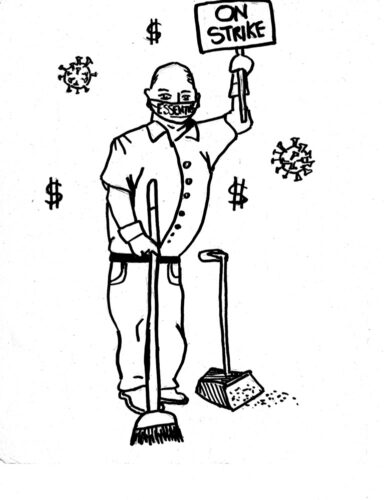Local Custodians Looking to Clean House of Unethical Labor Practices
By Loretta Bonifacio
datubonifacio@gmail.com
Picture this: a masked crowd of overworked, underpaid janitors picketing for fair pay and access to healthcare in front of the Salesforce Tower, San Francisco’s tallest building. Salesforce is the leading customer relationship management software company valued at $180 billion; the very same company that paid zero dollars in federal income taxes in 2020.
Salesforce’s reimagined ivory tower has equally affluent neighbors in the SoMa district; Google, Facebook, and Twitter occupy nearby offices. What do these tech giants have in common, aside from their profit margins?
These companies contract with the building service providers, Able Services and ABM Industries, who employ janitors from the Service Employees International Union (SEIU) Local 87.
Many of the janitors were furloughed when the pandemic prompted office closures, but they are now seeking to return to work as the city’s reopening efforts continuously improve.
The union reports that the majority of workers on strike are over 3,000 immigrant women of color fighting for equitable contracts that feature sick pay, wage increases, comprehensive health coverage, sexual harassment protections, and improved ventilation in the workplace.
Local 87 was one of the first SEIU locals established in the 1930s by George Hardy to represent janitors who worked in San Francisco office buildings. Today, Local 87 prioritizes immigrant justice through political mobilization, legislative action, and member education.

The singular scene depicted above from March 24 was part of a three-day strike orchestrated after eight months of ongoing contract negotiations with Able Services and ABM Industries. The struggle is characteristic of a modern-day, COVID-era San Francisco, where janitors must crusade for protections that should be inherently provided to them.
Since March 2020, janitors across the country have worked without sufficient personal protective equipment (PPE), like a regular rotation of masks and hand sanitizers.
Unfortunately, COVID-19 has devastated various workers in the service industry. In January 2021, UCSF found that 40% of workers in agriculture and food service doubled their risk of fatal infection. Latinos in those industries saw an increased chance of death at 60%.
Similarly, the Local 87 reported that at least 26 members died from COVID-19. The death of janitor and union member Alvaro Ruiz was a sobering loss that echoed Local 87’s motivations.
“We are essential, not expendable,” said janitor and Local 87 executive board member Ramiro Rodriguez. “We’ve risked our health to keep our country as clean and safe as possible. But who is looking out for us?”
The San Francisco Maintenance Contractors Association, which represents Able Services and ABM Industries, said that negotiations with Local 87 are ongoing. A compromise has yet to be reached.
San Francisco is not terribly old and its organized labor struggles are anything but new. Instructor of Labor and Community Studies Fred Glass, cited the Gold Rush of 1849 as a catalyst for California’s storied labor movement.
In his 2016 book, “From Mission to Microchip: A History of the California Labor Movement,” Glass noted that groups of workers understood, even then, the power of collective action.
When the cost of living reached exorbitant heights in November 1849, San Francisco carpenters lobbied for a daily wage increase of $12 to $16. After their employer rejected the increase, the carpenters mobilized in what would become the first recorded California labor strike. Their efforts landed on a compromised $1 increase of $13 and later, $14 per day.
One year later in 1850, newspaper printers founded the San Francisco Typographic Society. This would be the first union local founded on the West Coast.
Currently, there are 37 unions that represent employees in the City and County of San Francisco. From bricklayers to dentists, the employees under these unions enjoy the benefits of collective bargaining to leverage a safer, more democratic working environment.
The Local 87’s latest endeavor is to have all members vaccinated. When vaccine eligibility opened statewide for individuals over 16 on April 15, the feeling of optimism has never felt more palpable.
Upon reflecting on this piece and other journalistic writings this past year, a common theme that’s emerged is reckoning with loss, namely death. Death should never precede action, but we’re a country and state of extremes. Action is our ultimatum, our go-to tendency when pressure is applied and the center can no longer hold. But inaction, the state of convenient tolerance, might be worse. We could all learn from Local 87’s optimistic pursuit of a more ethical, promising existence. Our greatest work can’t happen without it.
